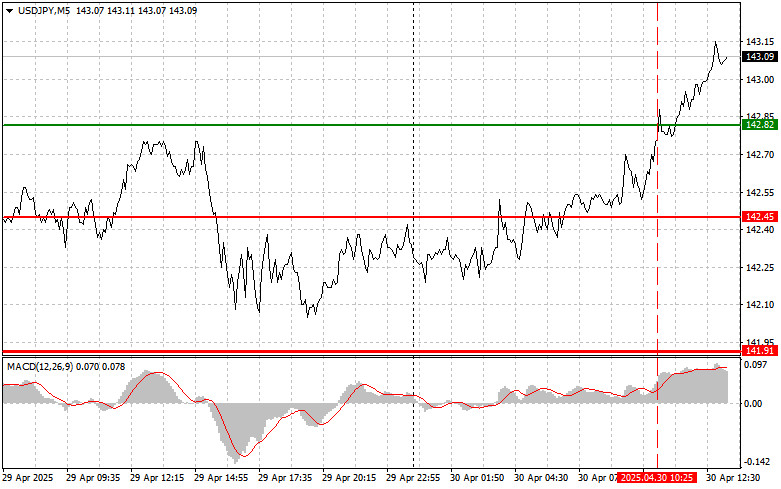Trade Analysis and Tips for Trading the Japanese Yen
The test of the 142.82 price level occurred at a time when the MACD indicator had already moved significantly above the zero mark, which limited the dollar's upward potential. For this reason, I did not buy.
In the second half of the day, pressure on the yen may increase. Strong reports on U.S. Q1 GDP and ADP employment growth will be sufficient for this. The Core Personal Consumption Expenditures (PCE) Index and data on U.S. household income and spending will also be in the spotlight for traders. Investors are closely watching macroeconomic indicators, as they are key measures of the U.S. economy's condition and, therefore, can influence the Federal Reserve's policy decisions.
Sustained growth in GDP and employment could strengthen the Fed's confidence in the resilience of the economy, pushing plans for interest rate cuts further into the future. This, in turn, would strengthen the U.S. dollar and pressure the yen.
The Personal Consumption Expenditures (PCE) Index is one of the most important inflation indicators monitored by the Fed. A significant drop in PCE could ease concerns about persistent inflation and prompt the Fed to adopt a more dovish stance. Meanwhile, data on changes in household income and spending will provide additional insight into consumer activity and overall economic health.
As for the intraday strategy, I will rely more on the implementation of Scenarios #1 and #2.
Buy Signal
Scenario #1: Today, I plan to buy USD/JPY upon reaching the entry point around 143.23 (green line on the chart), targeting a rise toward 143.83 (thicker green line on the chart). Around 143.83, I will exit long positions and open short positions in the opposite direction, expecting a 30–35 point move downward. Buying the pair today makes sense only after strong U.S. data. Important! Before buying, make sure the MACD indicator is above the zero mark and just beginning to rise from it.
Scenario #2: I also plan to buy USD/JPY today in the event of two consecutive tests of the 142.86 level when the MACD indicator is in the oversold zone. This would limit the pair's downward potential and lead to a market reversal upward. A rise toward the opposite levels of 143.23 and 143.83 can be expected.
Sell Signal
Scenario #1: I plan to sell USD/JPY today after breaking below the 142.86 level (red line on the chart), which would lead to a quick drop in the pair. The key target for sellers will be the 142.32 level, where I will exit sales and immediately open long positions in the opposite direction, expecting a 20–25 point move upward. Selling pressure on the pair may emerge at any moment today. Important! Before selling, make sure the MACD indicator is below the zero mark and just beginning to decline from it.
Scenario #2: I also plan to sell USD/JPY today in the event of two consecutive tests of the 143.23 level when the MACD indicator is in the overbought zone. This would limit the pair's upward potential and lead to a market reversal downward. A drop toward the opposite levels of 142.86 and 142.32 can be expected.
What's on the chart:
- Thin green line – the entry price where the trading instrument can be bought;
- Thick green line – the suggested price for placing Take Profit or manually securing profit, as further growth above this level is unlikely;
- Thin red line – the entry price where the trading instrument can be sold;
- Thick red line – the suggested price for placing Take Profit or manually securing profit, as further decline below this level is unlikely;
- MACD indicator – it is important to use overbought and oversold zones when entering the market.
Important. Beginner traders in the Forex market must be extremely cautious when deciding to enter the market. Before the release of important fundamental reports, it is best to stay out of the market to avoid being caught in sharp price swings. If you choose to trade during news releases, always set stop-loss orders to minimize losses. Without stop-losses, you can very quickly lose your entire deposit, especially if you do not use money management and trade large volumes.
And remember, successful trading requires a clear trading plan, like the one I presented above. Spontaneous decision-making based on current market conditions is inherently a losing strategy for an intraday trader.














